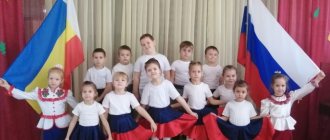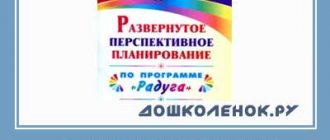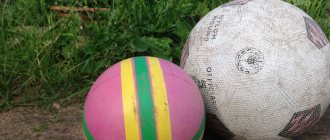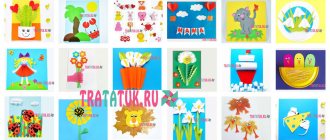Thematic planning of modeling classes in the senior group
Irina Lisitskaya
Thematic planning of modeling classes in the senior group
September
Topic: Mother tongue.
Lesson No. 1.
"Kalmyk Tales". (Kazakova, p. 124)
Goal: To consolidate the ability to convey the movement of figures in sculpting (jumping, lying, standing, a simple plot. To foster in children an interest in animals.
Topic: City Day.
Lesson No. 2.
"The children are dancing merrily." (Kazakova, p. 132)
Goal: To create a joyful mood in children. Be able to convey a human figure in motion.
Topic: Kindergarten.
Lesson No. 3.
“Make your favorite toy.” (Komarova, p. 99)
Goal: To teach children to create the image of their favorite toy. Strengthen various sculpting techniques with the whole hand and fingers. Cultivate the desire to finish what you start. Arouse an aesthetic attitude towards your works, teach them to evaluate them.
Topic: I am among people.
Lesson No. 4.
“We are walking in the area.” (Kazakova, p. 115)
Goal: To learn to depict children’s figures in winter clothes, to maintain proportions, to be able to connect parts by greasing, smoothing the joints, conveying simple movement (tilting, turning the body). Strengthen the figures on a common base.
October
Topic: Harvest.
Lesson No. 1.
“Vegetables (carrots, beets).” (Komarova, p. 86)
Goal: To teach children to convey the basic shape of vegetables (rounded, elongated, characteristic differences (rounded and elongated shapes), sculpt with the whole hand and fingers. Learn to smooth the surface. Develop the ability to analyze and evaluate their work.
Topic: Wild animals.
Lesson No. 2.
"Who lives in the autumn steppe." (Kazakova, p. 102)
Goal: To learn how to convey the characteristic features of animals using techniques for sculpting from a whole piece. Develop curiosity and instill in children an interest in animals.
Topic: Wild birds.
Lesson No. 3.
"Birds at the Feeder" (sparrows, pigeons). (Komarova, p. 126)
Goal: Learn to sculpt a bird in parts, convey the shape and relative size of the body and head, the difference in size of birds of different breeds, the correct position of the head, wings, and tail.
Theme: Autumn.
Lesson No. 4.
“The bear has mushrooms in the forest, I take years.” (Kazakova, p. 85)
Goal: To develop children's ideas and imagination, to teach them how to sculpt mushrooms and berries of different shapes from a whole piece of clay.
November
Topic: My country.
Lesson No. 1.
"Introduction to small sculpture." (D/V 1987, no. 9, p. 17,
1984, no. 6, p. 46)
Goal: To teach the ability to comprehend the artistic features of sculpture, using the method of circular inspection. Come up with a figurative idea, consciously selecting available techniques for conveying expressiveness. Develop the ability to give figurative names and your own assessment of works of sculpture.
Topic: My home.
Lesson No. 2.
“What was in the hut of the three bears?” (Kazakova, p. 106)
Goal: To teach children the ability to complement the images of a fairy tale with new objects, to develop children’s imagination, to sculpt a table, chairs and dishes (to create objects of different sizes).
Topic: Professions.
Lesson No. 3.
“Make whatever vegetables you want for the store game.” (T. S. Komarova, p. 88)
Goal: To consolidate the ability to convey the shape of different vegetables (carrots, beets, turnips, cucumbers, tomatoes, etc.). Learn to compare their shape with
geometric (ball, ovoid, find similarities and differences.
Instill a love for the sales profession. Learn to convey the characteristic features of each vegetable in modeling, using the techniques of rolling, smoothing with your fingers, pinching, and pulling.
Topic: Food.
Lesson No. 4.
“A jar of jam for Carlson.” (Complex classes, author O. V. Pavlova, p. 177) (modeling and decorative drawing on a three-dimensional form).
Goal: Learn to sculpt a cone in different ways (by rolling or pulling it out of a ball).
December
Topic: Zul.
Lesson No. 1.
"Borzg."
Goal: To teach children to think about the content of their work. Outline its execution and ways of depicting it. To cultivate a creative attitude towards modeling, the ability to bring a plan to completion. Learn in different ways, roll a sausage. Instill a love for traditions.
Topic: Pets.
Lesson No. 2.
"Kitty". (Komarova, p. 106)
Goal: To teach children to create an image of an animal. Strengthen the ability to create an animal figurine in parts, using different techniques: rolling clay between the palms, pulling small parts, connecting small parts by pressing and smoothing the joints. Instill a love for pets.
Topic: Poultry.
Lesson No. 3.
“Chickens are walking around, looking for worms, pecking at grains.” (Collective work) (Kazakova, p. 93)
Goal: To teach children to pass figurines of chickens in some simple position (stretched necks, pecking, drinking water, etc.). Use sculpting techniques, connect parts, smear.
Topic: New Year.
Lesson No. 4.
"Our guests at the Christmas tree festival." (Komarova, p. 113)
Goal: To teach children to convey impressions of the holiday in sculpting. Strengthen the ability to sculpt a person and various animals. Practice using different sculpting techniques. Learn to convey the images of guests at the New Year's party. Develop memory and imagination.
January
Subject: ___
Lesson No. 1.(—)
Theme: Winter
Lesson No. 2.
"Bunny". (Komarova, p. 112)
Goal: To consolidate the ability to sculpt animals, to convey the shape, structure and size of parts. Practice using a variety of modeling techniques. Learn to convey simple movements of a figure.
Topic: Folk games. Fun.
Lesson No. 3.
"Matryoshka" (Kazakova, p. 118)
Goal: To arouse children’s interest in the image, teach them to transfer a figurine from a whole piece, sculpt nesting dolls of different sizes, make a round dance from them, use additional details (colored stripes-skirts).
Topic: Clothes. Shoes.
Lesson No. 4.
"Girl in a winter coat." (Komarova, p. 108)
Goal: Learn to sculpt a human figure, correctly conveying the shape of clothing and body parts, observing proportions. Use learned techniques for connecting parts, smoothing out the fastening points.
February
Topic: My health.
Lesson No. 1.
"We're doing exercises." (Collective work) (O. V. Pavlova, Complex classes, p. 179, in group No. 2)
Goal: To learn to create a collective plot composition, analyze the features of the image of a person in motion, correlate parts by size and proportions; develop skills in working with plasticine; develop the ability to work in a team; instill a desire to lead a healthy lifestyle.
Topic: Transport.
Lesson No. 2.
“What do I want to fly on?” (O. V. Pavlova, Complex classes, p. 171, in group No. 2)
Goal: Learn to convey the shape of the main part of the product and additional parts, their proportions, roll balls and roll out strands, treat the surface with your fingers or a stack, achieving smoothness; develop imagination.
Topic: Tsagan sar. Maslenitsa.
Lesson No. 3.
"Borzg, Pancakes." (Komarova, p. 20)
Purpose: To consolidate the technique of rolling clay with straight, circular movements of the palms. Learn in different ways, rolling the resulting sausage and flattening the koloboks. Learn to look at works, highlight similarities and differences.
Topic: Our defenders.
Lesson No. 4.
"Border guard with a dog." (Komarova, p. 171)
Goal: To consolidate the ability to sculpt a person and an animal, to convey the characteristic features of the image. Practice using a variety of technical techniques: sculpting from a whole piece, smoothing, pulling, etc. continue to learn how to install figures on a stand.
March
Topic: Traditions. Customs.
Lesson No. 1.
"The children are dancing merrily." (Kazakova, p. 132)
Goal: To create a joyful mood in children, to be able to convey a human figure in motion (dancing).
Topic: I'm in the art world.
Lesson No. 2.
“I’ll decorate my mother’s cutting board.” (Decorative modeling). (O. V. Pavlova, Complex classes, p. 187, in group No. 2)
Goal: Learn to roll out a plate of clay, cut a rectangle out of it, and make a pattern in a stack; develop the ability to make a pattern; encourage initiative; develop the ability to evaluate your work.
Topic: Water. Seas, rivers, lakes.
Lesson No. 3.
"Bas-relief - Fish." (Kazakova, p. 119)
Goal: To teach children to compare different methods of depiction, to convey a semi-volumetric image using different materials, and to use stacking to finish a form.
Topic: Spring.
Lesson No. 4.
“What do you want to give your mom on March 8th?” (Kazakova, p. 125)
Goal: To instill in children love and care for their mother and grandmother, to make them want to please them with a gift, to teach them to use the acquired skills in various types of visual activities.
April
Topic: My Kalmykia.
Lesson No. 1.
"Animals of the steppes of Kalmykia."
Goal: To cultivate the desire to conceive interesting content for your modeling, to bring the work started to the end. Reinforce previously learned skills in animal sculpting. Foster initiative, independence, and creativity.
Topic: Planet Earth. Space.
Lesson No. 2.
"We're flying on a rocket." (Kazakova, p. 129)
Goal: To instill in children an interest in astronauts, develop imagination, creativity, sculpt a rocket figure by rolling and pulling plasticine.
Topic: Steppe. The work of people in nature.
Lesson No. 3.
"Horse". (Kazakova, p. 123)
Goal: To cultivate in children an interest in the work of folk craftsmen, to be able to sculpt a horse figurine from a whole piece, pulling out and pinching small parts, and, if desired, sculpt a human figurine.
Topic: Plants.
Lesson No. 4.
“Decorative plate – Flower”. (overlaying the form on the base)
Goal: To teach children to create decorative plates from clay (plasticine). Apply clay (plasticine) in an even layer on a board or cardboard, smooth it, wetting it with water, then draw a pattern in stacks, apply the clay in accordance with the pattern.
May
Topic: Victory Day.
Lesson No. 1.
"Mug for Grandpa." (O. V. Pavlova, Complex classes, p. 189, in group No. 2)
Goal: To arouse children's interest in making gifts for dads and grandfathers with their own hands; learn to sculpt dishes in a constructive way, precisely in advanced shape, size and proportions in accordance with the purpose of the item; develop creative imagination, compositional skills; cultivate a caring attitude towards loved ones.
Topic: My family.
Lesson No. 2.
“Little Red Riding Hood brings gifts to grandma.” (Komarova, p. 137)
Goal: To teach children to create images of fairy tales in modeling. Strengthen the ability to depict a human figure, convey the characteristic features and details of the image. Practice using different sculpting techniques and the ability to strengthen a figure on a stand. Teach figurative evaluation of your own work and the work of other children.
Topic: I am human. I'm growing.
Lesson No. 3.
“Mom, dad, me, friendly family.” (teamwork)
Goal: To teach children to convey small forms and large forms of human figures in sculpting. Strengthen the ability to depict a human figure. To cultivate the desire to perform modeling as best as possible, bringing the work started to completion. Develop independence and creativity.
Topic: Insects.
Lesson No. 4.
"Dragonfly". (Kazakova, p. 119)
Goal: To teach children to compare different methods of depiction. Convey a semi-volume image, use a stack to finish the form.




